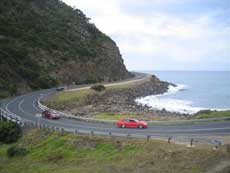| South West (Shipwreck) Coast of Victoria |
![]() The south west coastal region of Victoria takes in The Great Ocean Road. One of Australia's and the world's great ocean drives, it is a 273 km stretch of highway between the towns of Torquay and Warrnambool. The road winds alongside some of the most dramatically scenic seascapes in the world. It was constructed by ex-servicemen and the unemployed between 1918 and 1932 and is dedicated to those that lost their lives in World War I. The road passes through the popular holiday resort of Lorne, the fishing town of Apollo Bay, and then it heads inland traversing the lush Otway National Park. The final leg covers the "Shipwreck Coast" where many 19th Century vessels ran aground on their journey from England. The most well known feature in the region is The Twelve Apostles rock formation near Port Campbell, carved out of the limestone headlands by rough seas over time.
The south west coastal region of Victoria takes in The Great Ocean Road. One of Australia's and the world's great ocean drives, it is a 273 km stretch of highway between the towns of Torquay and Warrnambool. The road winds alongside some of the most dramatically scenic seascapes in the world. It was constructed by ex-servicemen and the unemployed between 1918 and 1932 and is dedicated to those that lost their lives in World War I. The road passes through the popular holiday resort of Lorne, the fishing town of Apollo Bay, and then it heads inland traversing the lush Otway National Park. The final leg covers the "Shipwreck Coast" where many 19th Century vessels ran aground on their journey from England. The most well known feature in the region is The Twelve Apostles rock formation near Port Campbell, carved out of the limestone headlands by rough seas over time.
See also: Western Districts | Surf Coast | The Grampians
Prior to reaching the Great Ocean Road from Melbourne is the city of Geelong, the second largest city in Victoria. Set on the banks of the Barwon River and fronting Corio Bay, the city boasts a population of over 200,000 including surrounding suburbs. To the east of Geelong is the Bellarine Peninsula. Linked by a car and passenger ferry to the neighbouring Mornington Peninsula, the Bellarine Peninsula is Geelong's playground, consisting of swimming and surf beaches and legacies of maritime history including lighthouses, historic buildings and museums. The district's hinterland is part of Victoria's Western Districts, a rich farming area from which the majority of Victoria's pastoral wealth is gleaned. It carries one-third of the state's sheep and cattle population.
 |
![]() |
![]() |
| The Great Ocean Road |
Beauchamp Falls |
The Grotto, Port Campbell NP |
The Great Ocean Walk: a 91 km trail that traverses the rugged coastline, taking walkers on an unforgettable journey along breath-taking coastline, atop some of Australia's tallest sea cliffs, splashing through pristine streams, along untouched beaches and into secluded campsites. The eight-day seven-night walk, which begins in Apollo Bay and ends at Glenample Homestead, adjacent to the iconic limestone stacks of the Twelve Apostles. Sections the walk may be traversed for those who have neither the time or inclination to complete the whole 91 km. Some of the walk is based on the track blazed by Port Phillip District Superintendent Charles Joseph La Trobe in March 1846. After the loss of almost 400 lives when the Cataraqui sank off nearby King Island, La Trobe was charged with surveying Cape Otway for the establishment of a lighthouse. Walkers also retrace the footsteps of the first Cape Otway lightkeepers and their staff who travelled along the coastline to retrieve life-saving cargo from supply ships. Website
The Great Ocean Road: this road follows much of the rugged Victorian south-west coast. This road was constructed by ex-servicemen and the unemployed between 1918 and 1932 and is dedicated to those that lost their lives in World War I. The road passes through the popular holiday resort of Lorne, the fishing town of Apollo Bay, and then it heads inland traversing the lush Otway National Park. The final leg covers the "Shipwreck Coast" where many vessels in the 1800s ran aground on their journey from England. The most famous attraction in the region is The Twelve Apostles rock formation near Port Campbell, carved out of the limestone headlands by rough seas over time.
![]() |
![]() |
![]() |
| Port Campbell National Park |
Apollo Bay National Park |
Jaws of Death, The Grampians |
|
|
Best Time To Go: As Victoria has a temperate climate, there is no one season or month that the visitor needs to avoid, except perhaps summer (December - February), if you find hot weather unbearable. Even then, only the north and the north-west tend to suffer from extended periods of intense heat, so those areas would be the only ones to contemplate avoiding in summer if you don't like the heat. In and around Melbourne, which gets more cloud and disturbed weather despite a lower rainfall, sunshine hours per day in winter (June - August) are three to four as against seven to eight in summer. Cold spells are brief and never severe on the coast, and temperatures can drop much lower inland in winter.
![]()
|